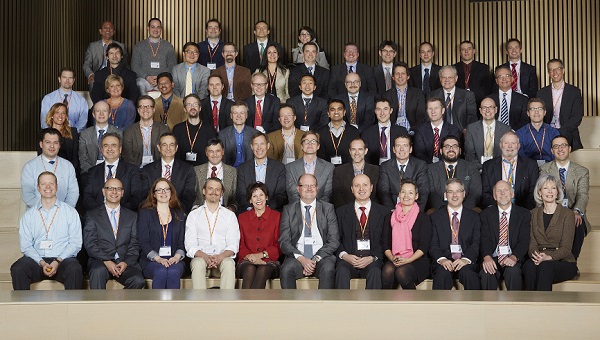Copenhagen, DK April 24 – Leading surgeons from North America, Europe, Israel and Turkey recently gathered in Copenhagen for Oticon Medical’s Scientific Meeting on tissue preservation surgery. The three-day conference at Oticon Medical’s international headquarters brought together prominent clinicians, researchers and thought leaders in otology/neurology and audiology to share experiences and exchange knowledge about tissue preservation in bone anchored hearing implant surgery.
“Our goal is to provide forums that report on the newest data and observations from the clinical world, especially those that identify and use clinical outcome measures that are patient-centered,” said Oticon Medical President Jes Olsen. “By creating opportunities for internationally recognized experts in otology/neurology and related healthcare disciplines to explore advances together, we aim to provide focused, educational experiences that generate understanding and acquisition of new competencies, skills, theoretical foundations and methods.”

Peter Roland, MD, Professor and Chair of the Department of Otolaryngology-Head and Neck Surgery at UT Southwestern Medical Center, presented a report on Single-Stage Osseointegrated Hearing Implant Surgery in Children. In his presentation, he compared skin complications after one-stage and two-stage surgery in 65 children and reported that the percentage of skin complications did not change.
A presentation by Johan Wolfaardt, BDS MDent (Prosthodontics), Director of the Institute of Reconstructive Sciences in Medicine and Professor in the Faculty of Medicine and Dentistry, University of Alberta, Canada, explored skin response after bone conduction implantation. Dr. Wolfaardt discussed the need to increase awareness and understanding of the management of skin inflammation in the long term. He called for the establishment of a network where surgeons could come together to explore better ways to describe and define skin reactions that are more accurate than those available in the currently used Holger’s scale.
Cor Cremers, MD, PhD, Professor Emeritus of ENT-Otology at the Radbound University in Nijmegen, The Netherlands, discussed the long-term history and clinical outcomes for the linear incision technique. Dr. Cremers presented data on the incidence of soft tissue reactions, implant failures, revision surgery and implant stability on more than 1,000 patients including children. His colleague, Arjan Bosman., PhD, gave an overview of the experience of Nijmegen, where the first bone anchored implants were performed in the early 1990s, and the evolution of the technology and its application to a variety of indications and hearing losses.
Avi Goldfarb, MD of the Edith Wolfson Medical Center, Holon, Israel, discussed the benefits of surgery without tissue reduction for bone anchored hearing solutions. In his study, this relatively new approach to bone anchored implant surgery has been shown to be beneficial in terms of reducing peri-implant infections, numbness around the implant and surgery time.
Shyam Singam, FRCSI, Associate Specialist ENT Surgeon, Torbay Hospital, Devon, UK, discussed a method of bone anchored surgery without soft tissue reduction. Originally offered in a clinical trial to patients with comorbidities that could interfere with surgery and wound healing, Torbay Hospital now offers the treatment option to all patient who are candidates for bone anchored solutions.
In his presentation, Daniel Coelho, MD, FACS of the Virginia Commonwealth University School of Medicine, Richmond, talked about “respect for tissue” and shared his work with the Punch Technique, a minimally invasive, tissue sparing technique for percutaneous bone anchored implants. In following up his patients for a period of up to 2 years, he noticed no adverse skin reactions, no need for the use of topical medication or steroids, no implant extrusion and no delay in the fitting of the sound processor.
Soren Foghsgaard, MD of Rigshospitalet/Gentofte Department of Otolaryngology – Head & Neck Surgery, presented findings of a 12-month prospective study of the Ponto Wide Implant. The study showed that use of a wider (4.5 mm) implant improves stability of the implant in bone. Dr. Foghsgaard explained that the improved stability suggests that it may be possible to load the bone anchored processor sooner than the post-operative timeframe now used.
The conference also included an information session on Ponto implant and abutment design lead by Patrik Westerkull, MSc. Eng. Ph., Senior Research Consultant to Oticon Medical.
The conference concluded with a series of roundtable discussions. There was general agreement that linear incision without skin thinning and tissue reduction has produced the best results in the short follow-up time, including enhanced cosmetics, shorter healing time and decreased post operative complications. However, the general consensus was that it was too early to draw conclusions on this new surgical method and long term studies on more patients are clearly warranted.
“The techniques used in bone anchored implant surgery are typically based on the surgeons’ personal preferences and who their mentors are,” explained Ravi Sockalingam, PhD, Oticon Medical Director of Clinical Research and Professional Relations. “Methods are based on philosophy and what implant technique information the surgeon has access to. While the data shared at our meetings is still fairly new, it provides vital access to what is happening in the clinical world. Oticon Medical will continue to create forums for surgeons to share and explore results with the goal of achieving the absolute best results possible for patients.”
Expert presenter Dr. Roland echoed Sockalingam’s observation, “I learned a lot from the other attendees, especially other surgeons." Peter Darley, MD also commented on the value of the professional networking that the conference provided to all participants: “Overall the meeting provided a venue for relevant up-to-date topics in the realm of osseointegrated implants. It was great to network with other surgeons on both sides of the Atlantic and learn ways to evolve my own practice.”
For more information on bone anchored hearing solutions, Oticon Medical and the Ponto System, visit www.oticonmedical.com or the Oticon Medical Expo Page on AudiologyOnline.

